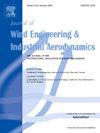Sensitivity analysis of wavy wall performance in turbulent separation control: Effects of amplitude and period variations
IF 4.2
2区 工程技术
Q1 ENGINEERING, CIVIL
Journal of Wind Engineering and Industrial Aerodynamics
Pub Date : 2025-02-21
DOI:10.1016/j.jweia.2025.106048
引用次数: 0
Abstract
The influence of transversely oriented sinusoidal wall corrugation on an incompressible isothermal flow in the near-wall region, subjected to adverse pressure gradient conditions at a friction Reynolds number of , is investigated using Large Eddy Simulation. This study is a continuation of the work (Kamiński et al., 2024) devoted to dynamics of the flow in the regions of crests and downhill/uphill waviness parts, and where the impact of the local and global pressure gradient were analysed. It focuses on the influence of the waviness parameters, such as amplitude () and number of waviness periods () on the turbulent boundary layer separation. In terms of the effective slope, , where is the streamwise direction, the analysed cases included the configurations with ranging from (flat wall) to (, where is the length of a single waviness). Specifically, the primary objective was to identify a combination of and that would result in the greatest increase in the wall-shear stress , relative to the flat plate configuration, aiming to achieve the maximum postponement of turbulent separation. It is shown that the waviness significantly affects the flow field by enhancing the turbulent kinetic energy that leads to increased . In particular, it is shown that the enhancement in TKE depends mainly on and not on particular values of and . Namely, the cases which are significantly diversified by and but are characterised by the same exhibit almost identical TKE profiles. The highest increase in the wall-shear stress compared to the reference flat plate configuration was observed for the combination of and corresponding to .
湍流分离控制中波浪壁性能的敏感性分析:振幅和周期变化的影响
在摩擦雷诺数Reτ=2500条件下,采用大涡模拟方法研究了横向定向正弦壁面波纹对近壁面不可压缩等温流动的影响。这项研究是对波峰区域和下坡/上坡波浪形部分流动动力学的研究(Kamiński等人,2024)的延续,其中分析了局部和全局压力梯度的影响。重点研究了波动参数振幅(A)和波动周期数(Nλ)对湍流边界层分离的影响。有效斜率ES∝|dA/dx|,其中x为流向,所分析的情况包括ES=0(平壁)至ES=0.2455 (A/λ=0.051,其中λ为单个波浪形的长度)的配置。具体来说,主要目标是确定a和Nλ的组合,这将导致最大的壁面剪切应力τw的增加,相对于平板配置,旨在实现最大的延迟湍流分离。结果表明,波纹度对流场的影响是显著的,它通过增大湍流动能而导致τw增大。特别是,TKE的增强主要取决于ES,而不是特定的A和Nλ值。也就是说,由A和Nλ显著多样化但具有相同ES特征的情况表现出几乎相同的TKE谱。在ES=0.1473时,与参考平板配置相比,A和Nλ组合的壁面剪切应力增加最大。
本文章由计算机程序翻译,如有差异,请以英文原文为准。
求助全文
约1分钟内获得全文
求助全文
来源期刊
CiteScore
8.90
自引率
22.90%
发文量
306
审稿时长
4.4 months
期刊介绍:
The objective of the journal is to provide a means for the publication and interchange of information, on an international basis, on all those aspects of wind engineering that are included in the activities of the International Association for Wind Engineering http://www.iawe.org/. These are: social and economic impact of wind effects; wind characteristics and structure, local wind environments, wind loads and structural response, diffusion, pollutant dispersion and matter transport, wind effects on building heat loss and ventilation, wind effects on transport systems, aerodynamic aspects of wind energy generation, and codification of wind effects.
Papers on these subjects describing full-scale measurements, wind-tunnel simulation studies, computational or theoretical methods are published, as well as papers dealing with the development of techniques and apparatus for wind engineering experiments.

 求助内容:
求助内容: 应助结果提醒方式:
应助结果提醒方式:


